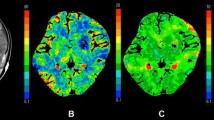Abstract
The noninvasive xenon-enhanced CT (Xe CT) cerebral blood flow (CBF) method has been used in patients with severe traumatic brain injury (TBI) to identify the blood-flow thresholds for the development of irreversible ischaemia or infarction following severe TBI. Quantitative regional CBF (rCBF) estimates are based on the assumption of identity between the end-tidal xenon concentration curve, used as the input function, and the arterial xenon concentration curve, being the true input function to the brain. Accordingly, rCBF data addressing the issue of ischaemia should be viewed in relation to possible deviations between the end-tidal and arterial xenon concentration curves. To evaluate this possible source of error, we studied five patients with severe TBI (Glasgow coma score ≤ 7) who also had pulmonary trauma. CBF was studied with the Xe CT CBF method and flow rates were determined by fitting the Kety equation to each CT voxel using either the end-tidal or the arterial xenon curve as input function. In all patients rCBF estimates were lower using the end-tidal xenon curve than with the arterial xenon curve; the mean underestimation was 20.3 % in gray metter and 17.3 % in white matter. The deviation between the end-tidal and arterial xenon concentration curves should be considered as a source of error when defining critical flow values according to the flow thresholds of tissue viability
Similar content being viewed by others
Author information
Authors and Affiliations
Additional information
Received: 1 June 1999/Accepted: 23 July 1999
Rights and permissions
About this article
Cite this article
von Oettingen, G., Bergholt, B., Østergaard, L. et al. Xenon CT cerebral blood flow in patients with head injury: influence of pulmonary trauma on the input function. Neuroradiology 42, 168–173 (2000). https://doi.org/10.1007/s002340050039
Issue Date:
DOI: https://doi.org/10.1007/s002340050039




